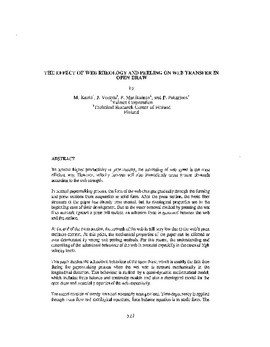| dc.contributor.author | Kurki, M. | |
| dc.contributor.author | Vestola, J. | |
| dc.contributor.author | Martikainen, P. | |
| dc.contributor.author | Pakarinen, P. | |
| dc.contributor.other | International Conference on Web Handling (1997) | |
| dc.date.accessioned | 2019-11-05T18:28:44Z | |
| dc.date.available | 2019-11-05T18:28:44Z | |
| dc.date.issued | 1997-06 | |
| dc.identifier | oksd_icwh_1997_kurki | |
| dc.identifier.citation | Kurki, M., Vestola, J., Martikainen, P., & Pakarinen, P. (1997, June). The effect of web rheology and peeling on web transfer in open draw. Paper presented at the Fourth International Conference on Web Handling (IWEB), Stillwater, OK. | |
| dc.identifier.uri | https://hdl.handle.net/11244/321728 | |
| dc.description.abstract | To achieve higher productivity in papermaking, the increasing of web speed is the most efficient way. However, velocity increase will also immediately cause greater demands according to the web strength. | |
| dc.description.abstract | In normal papermaking process, the form of the web changes gradually through the forming and press sections from suspension to solid form. After the press section, the basic fiber structure of the paper has already been created, but its rheological properties are in the beginning state of their development. Due to the water removal method by pressing the wet fiber network against a press roll surface, an adhesion force is generated between the web and the surface. | |
| dc.description.abstract | At the end of the press section, the strength of the web is still very low due to the web's great moisture content. At this point, the mechanical properties of the paper can be affected or even deteriorated by wrong web peeling methods. For this reason, the understanding and controlling of the adhesional behaviour of the web is essential especially in the cases of high velocity levels. | |
| dc.description.abstract | This paper studies the adhesional behaviour of the open draw, which is usually the first time during the papermaking process when the wet web is stressed mechanically in the longitudinal direction. This behaviour is studied by a quasi-dynamic mathematical model, which includes force balance and continuity models and also a rheological model for the open draw and material properties of the web respectively. | |
| dc.description.abstract | The model consists of steady-state and nonsteady-state portions. Time-dependency is applied through mass flow and rheological equations, force balance equation is in static form. The solving method for this coupled equation system is to first solve the ideal steady-state situation and, after this nonsteady-stale equations which can be solved by using the steady-state situation as an initial condition. | |
| dc.description.abstract | The qualitative behaviour of this model is correct, for example the increase in peeling angle between the surface and the web can be observed in cases of both velocity increase and adhesion energy increase even if the relative speed difference of the open draw has remained constant. Limitations appear mainly in the correctness of web material, adhesion and external pressure parameters. However, by using this model, also the effects of such external disturbances as adhesion and pressure disturbances can be studied efficiently. | |
| dc.description.abstract | One of the main results is also an exponential increase in the peeling angle as a function of velocity. In this paper, it is caused by the centripetal force affecting the web. | |
| dc.description.abstract | As a conclusion, the peeling behaviour of the wet web in an open draw is a very sensitive system. The main advantage of this system is its capability to self-adjustment through changes of the mass flow rate and peeling angle. However, also the rheological properties of the web and the adhesion force itself play a significant role in the optimization and stabilization of the web transfer in an open draw. | |
| dc.format | application/pdf | |
| dc.language | en_US | |
| dc.publisher | Oklahoma State University | |
| dc.rights | In the Oklahoma State University Library's institutional repository this paper is made available through the open access principles and the terms of agreement/consent between the author(s) and the publisher. The permission policy on the use, reproduction or distribution of the article falls under fair use for educational, scholarship, and research purposes. Contact Digital Resources and Discovery Services at lib-dls@okstate.edu or 405-744-9161 for further information. | |
| dc.title | Effect of web rheology and peeling on web transfer in open draw | |
| osu.filename | oksd_icwh_1997_kurki.pdf | |
| dc.type.genre | Conference proceedings | |
| dc.type.material | Text | |
